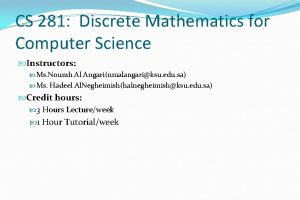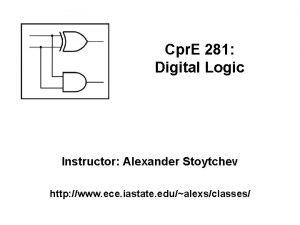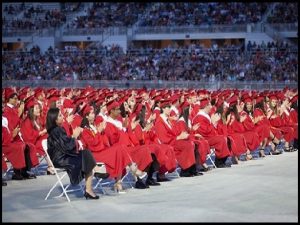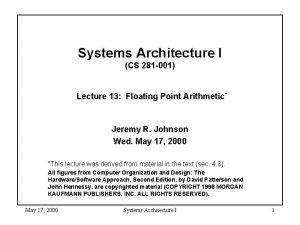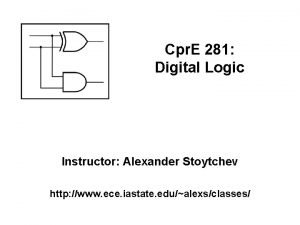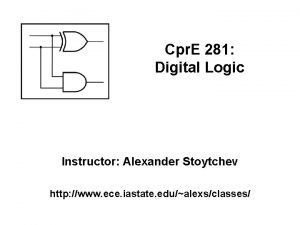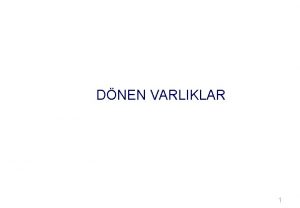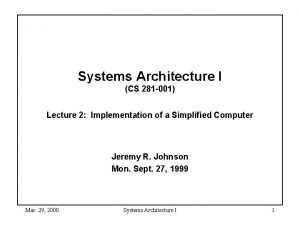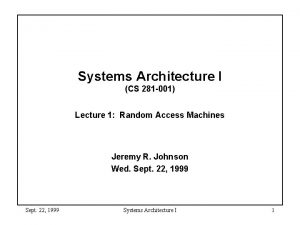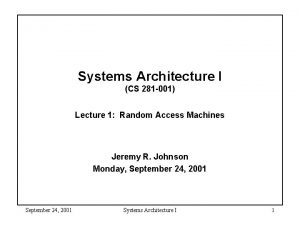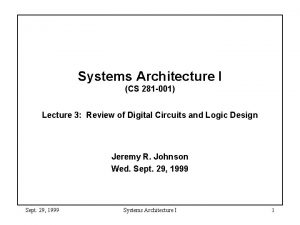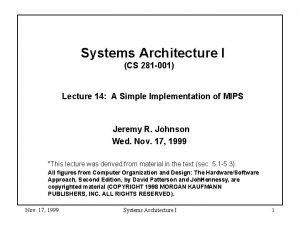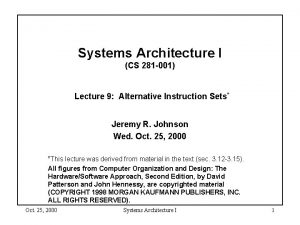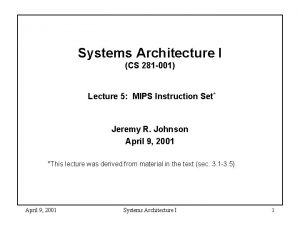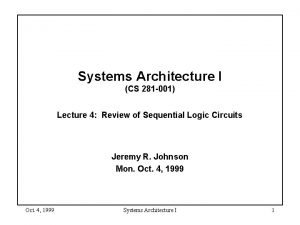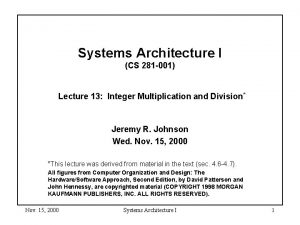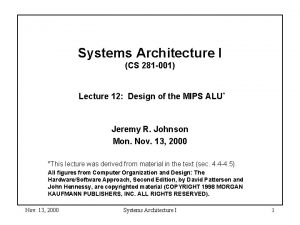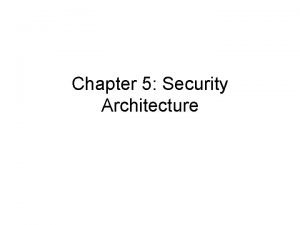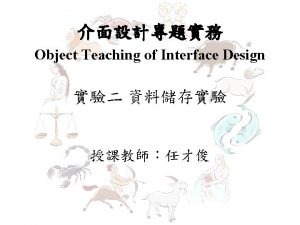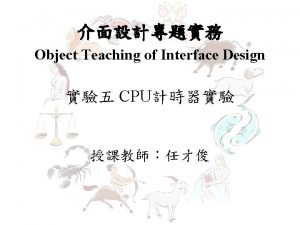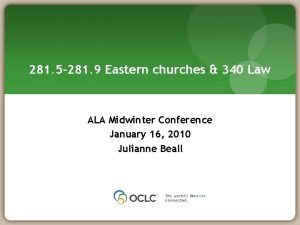Systems Architecture I CS 281 001 Lecture 6
















- Slides: 16

Systems Architecture I (CS 281 -001) Lecture 6: Branching and Procedures in MIPS* Jeremy R. Johnson Wed. Apr. 12, 2000 *This lecture was derived from material in the text (sec. 3. 5 -3. 6). Apr. 12, 2000 Systems Architecture I 1

Introduction • Objective: To illustrate how programming constructs such as conditionals, loops and procedures can be translated into MIPS instructions. Apr. 12, 2000 Systems Architecture I 2

Control Flow • if statements, if-else statements • Compiling an if-else statement if (i == j) f = g + h; else f = g - h; Assume f through j in $s 0 through $s 4 bne $s 3, $s 4, Else add $s 0, $s 1, $s 2 j Exit Else: sub $s 0, $s 1, $s 2 Exit: Apr. 12, 2000 Systems Architecture I 3

Compiling a Less Than Test • Use slt instruction (only branch on equal or not equal) if (a < b) … slt $t 0, $s 1 # $t 0 gets 1 if $s 0 < $s 1 0 otherwise bne $t 0, $zero, Less # goto Less if $t 0 0 • MIPS does not include a blt since it is “too complicated” and would increase the complexity of its implementation. Apr. 12, 2000 Systems Architecture I 4

Loops • Compiling a while loop (Assume i, j, k correspond to $s 3, $s 4, and $s 5 and that the base address of save is in $s 6) while (save[i] == k) i = i + j; Loop: add $t 1, $s 3 add $t 1, $t 1 add $t 1, $s 6 lw $t 0, 0($t 1) bne $t 0, $s 5, Exit add $s 3, $s 4 j Loop # $t 1 = 2 i # $t 1 = 4 i # address of save[i] # goto Exit if save[i] k #i=i+j Exit: Apr. 12, 2000 Systems Architecture I 5

Switch Statement • Use a “jump table” switch (k) { case 0: case 1: case 2: case 3: } f = i + j; break; f = g + h; break; f = g - h; break; f = i - j; break; • Variables f - k in $s 0 - $s 5, $t 2 contains 4, $t 4 contains address of jump table - JT Apr. 12, 2000 slt $t 3, $s 5, $zero # k < 0? bne $t 3, $zero, Exit slt $t 3, $s 5, $t 2 # k < 4? beq $t 3, $zero, Exit add $t 1, $s 5 add $t 1, $t 1 add $t 1, $t 4 # addr JT[k] lw $t 0, 0($t 1) # JT[k] jr $t 0 L 0: add $s 0, $s 3, $s 4 j Exit L 1: add $s 0, $s 1, $s 2 j Exit. . . Systems Architecture I 6

Procedures • In the execution of a procedure, the program must follow these steps: – Place parameters in a place where the procedure can access them – Transfer control to the procedure – Acquire the storage resources needed for the procedure – Perform the desired task – Place the result in a place where the calling program can access it – Return control to the point of origin Apr. 12, 2000 Systems Architecture I 7

Registers for Procedure Calling and the jal Instruction • $a 0 - $a 3: four argument registers in which to pass parameters • $v 0 - $v 1: two value registers in which to return values • $ra: one return address register to return to the point of origin • jal Procedure. Address: instruction to transfer control to a procedure and store the return address in $ra ($ra is set to PC + 4, address of the next instruction after procedure call) • jr $ra - used to transfer control back to the calling program Apr. 12, 2000 Systems Architecture I 8

Saving Registers using a Stack • Additional registers used by the called procedure must be saved prior to use, or the values used by the calling procedure will be corrupted. • The old values can be saved on a stack (call stack). After the called procedure completes, the old values can be popped off the stack and restored. • $sp: stack pointer register contains the address of the top of the stack. By convention, address on the stack grows from higher addresses to lower address, which implies that a push subtracts from $sp and a pop adds to $sp. Apr. 12, 2000 Systems Architecture I 9

Register Conventions • The 8 “saved” registers $s 0 - $s 7 must be preserved on a procedure call, i. e. the called procedure must save these before using them. • The 10 “temporary” registers $t 0 - $t 9 are not preserved by the called procedure. The calling procedure can not assume they will not change after a procedure call and, hence, must save them prior to the call if the values are needed after the call. • Saved registers should be used for long lived variables, while temporary registers should be used for short lived variables Apr. 12, 2000 Systems Architecture I 10

Nested Procedures and Automatic Variables • A new call frame or activation record must be created for each nested procedure call. • Argument registers and the return address register must be saved in addition to saved registers since new values will be put in them for the nested procedure call. • Automatic variables (i. e. variables that are local to a procedure and are discarded when the procedure completes) are also allocated on the call stack. They are popped when the call completes. Apr. 12, 2000 Systems Architecture I 11

Activation Records (Frames) and the Call Stack • An activation record (frame) is a segment on the stack containing a procedure’s saved registers and local variables. • Each time a procedure is called a frame ($fp: frame pointer register points to the current frame) is placed on the stack. Apr. 12, 2000 Systems Architecture I 12

Leaf Procedure /* Example from page 134 */ int leaf_example (int g, int h, int I, int j) { int f; f = (g+h) - (i+j); return f; } Apr. 12, 2000 Systems Architecture I 13

Leaf Procedure sub sw $sp, 4 $s 0, 0($sp) # push stack and save registers add sub add $t 0, $a 1 $t 1, $a 2, $a 3 $s 0, $t 1 $v 0, $s 0, $zero #g+h #i+j # (g+h) - (i+j) # return f = (g+h)-(i+j) lw $s 0, 0($sp) add $sp, 4 jr $ra Apr. 12, 2000 # restore registers and pop stack # return to calling program Systems Architecture I 14

Recursive Procedure /* Factorial example from pp. 136 -137 */ int fact(int n) { if (n < 1) return(1); else return(n * fact(n-1)); } Apr. 12, 2000 Systems Architecture I 15

sub sw sw $sp, 8 $ra, 4($sp) $a 0, 0($sp) # push stack # save return address # save n slt $t 0, $a 0, 1 # test n < 1 beq $t 0, $zero, L 1 # branch if n >= 1 add $v 0, $zero, 1 # return 1 add $sp, 8 # pop stack jr $ra # return to calling procedure L 1: sub $a 0, 1 jal fact lw $a 0, 0($sp) lw $ra, 4($sp) mul $v 0, $a 0, $v 0 # set parameter to n-1 # call fact(n-1) # restore previous value of n # restore previous return address # return n * fact(n-1) add $sp, 8 jr $ra # pop stack # return to calling procedure Apr. 12, 2000 Systems Architecture I 16
 Ipx 281
Ipx 281 Cs281 wordpress
Cs281 wordpress Cpr e 281
Cpr e 281 It is a circular or elliptical anticlinal structure
It is a circular or elliptical anticlinal structure Granite weathering
Granite weathering 281-284-0027
281-284-0027 Cs 281
Cs 281 Numeros romanos del 1 al 100
Numeros romanos del 1 al 100 Stoytchev 281
Stoytchev 281 Stoytchev 281
Stoytchev 281 18 gelecek aylara ait giderler ve gelir tahakkukları
18 gelecek aylara ait giderler ve gelir tahakkukları Dönem ayirici hesaplar 180 181 280 281 380 381
Dönem ayirici hesaplar 180 181 280 281 380 381 01:640:244 lecture notes - lecture 15: plat, idah, farad
01:640:244 lecture notes - lecture 15: plat, idah, farad Computer architecture lecture notes
Computer architecture lecture notes Isa definition computer
Isa definition computer Operating systems lecture notes
Operating systems lecture notes Lecture sound systems
Lecture sound systems

